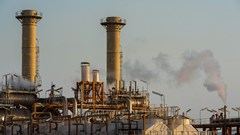Norway Gets First Ship to Carry Waste Carbon to Undersea Storage
(Bloomberg) -- The first ship in a 30 billion-kroner ($2.7 billion) plan to store emissions under the North Sea arrived in Norway as the country seeks to transform nascent carbon-capture technology into a commercial business.
The Northern Pioneer will be one of four vessels transporting waste carbon dioxide from industrial sites to a storage facility outside Bergen. From there, the gas will be pumped into a saline aquifer more than a mile below the seabed.
The so-called Longship project is due to be the world’s first large-scale carbon capture and storage hub for industrial emissions. Countries across Europe — most notably Germany but also Nordic nations — are betting on CCS to clean up polluting sectors such as cement, fertilizers and steel. Yet the technology is complex and costly, and remains largely at the demonstration phase.
Norway has sought to position itself as a leader in the space, committing billions in public funding to the Longship venture, and the project is an important test of what’s feasible.

The Northern Pioneer, which was built in Dalian, China, is powered primarily by liquefied natural gas. It can carry as much as 8,000 tons of fluid carbon dioxide, according to owner Northern Lights, a joint venture split between oil companies Equinor ASA, Shell Plc and TotalEnergies SE.
A Heidelberg Materials AG cement plant south of Oslo is set to begin capturing waste carbon toward the middle of the year. It’ll be the first customer of the Northern Lights’ project, whose first phase is due to inject and store as much as 1.5 million tons of CO2 a year.
©2025 Bloomberg L.P.
KEEPING THE ENERGY INDUSTRY CONNECTED
Subscribe to our newsletter and get the best of Energy Connects directly to your inbox each week.
By subscribing, you agree to the processing of your personal data by dmg events as described in the Privacy Policy.
More gas & LNG news

Spain Wants EU to Keep Methane Goals in Search for LNG Supplies

Booming Power Demand Means Longer Wait for GE Vernova Customers

US Widens Sanctions on Iran to Target Lucrative Gas Exports

China Stops Imports of US LNG Amid Trade War, Custom Data Shows

China’s Shipowners Seek to Continue Talks With US on Levies

EU’s Costa Says Russian LNG Phase-Out Makes Room for US Supplies

Fracker Liberty’s Profit Falls to 3-Year Low as Oil Slumps

Uniper and Woodside sign LNG supply agreements

Vista Buys Petronas’ Argentina Oil Stake in $1.5 Billion Deal
















